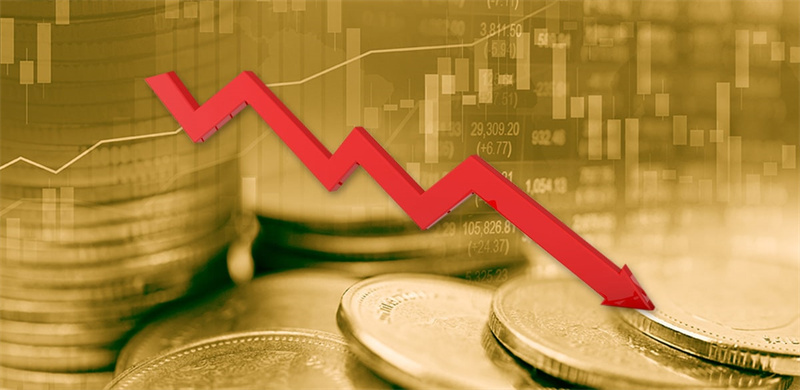In the realm of finance and economic trends, one indicator takes the spotlight as a pivotal gauge for understanding the prowess of the United States dollar – let’s explore the Dollar Index Chart.
This versatile tool spills the beans on how the greenback stacks up against a mix of other major global currencies. So, let’s dive deep into the intricacies of this chart and get a feel for its significance on the worldwide stage.
Unraveling the Dollar Index Chart

The Dollar Index Chart, also known as the USDX, is like the rockstar of the financial world, spinning tracks that represent the US dollar’s value against a line-up of the world’s heavyweight currencies. Think of it as a DJ mixing beats with the euro, Japanese yen, British pound, Canadian dollar, Swedish krona, and Swiss franc.
As the dollar’s swagger rises or falls compared to these currencies, the chart delivers the freshest insights.
Why the Dollar Index Chart Matters
Reading the Economic Pulse
One of the primary gigs of the Dollar Index Chart is to gauge the overall economic vibe of the good ol’ USA. When this chart is on an upward trajectory, it’s a sign that the dollar is flexing its muscles, indicating economic fireworks like boosted exports and international investments.
Impact on Investment Moves
Investors worldwide have their radar locked onto the Dollar Index Chart. A rising dollar can influence investment strategies, as it may translate into more significant returns for foreign investors diving into US assets. Conversely, a drooping dollar could put a damper on foreign investments in the US.
Trade Showdown and Exports
The Dollar Index Chart serves as a backstage pass to the US trade scene. A pumped-up dollar can make US exports shine like the hottest concert ticket in town, but it might also inflate the trade deficit. Conversely, a chilled-out dollar can amp up exports and help trim down the trade deficit.
Forex on the Block
In the world of forex trading, the Dollar Index Chart is the headline act. Traders use it to read the dance floor and make savvy moves. When the chart is on the upswing, it could be time to bet big on the dollar, while a downbeat chart might encourage some short-term moves.
The Dollar Index Chart’s Recent Groove
Riding the Rollercoaster
Recently, the Dollar Index Chart has been on a wild rollercoaster ride. Factors like shifts in interest rates, geopolitical curveballs, and economic data reveals have added some serious spice to the mix.
The Pandemic’s Encore
The COVID-19 pandemic threw a curveball at global economies. The Dollar Index Chart showed some wild moves during this time, as investors sought refuge in the US dollar during those turbulent times.
Examining the Crystal Ball
As we look into the future, the Dollar Index Chart remains an essential backstage pass for economists, investors, and traders. Its rhythms provide critical insights into the global economic symphony.
To summarize, the Dollar Index Chart is more than simply a collection of data; it provides a window into the financial muscle of the United States as well as a compass for navigating the complex world of finance. Understanding its vibes could be your ticket to controlling the financial world’s dance floor.
Foreign Commerce and the Dollar Index
The Dollar Index Chart has a significant impact on the dynamics of international trade. It impacts not only the United States, but other countries that trade with the United States. Here are some of the ways it affects international trade:
Currency Exchange Rates
The changes of the Dollar Index Chart can have a considerable impact on exchange rates between the US dollar and other currencies. When the dollar appreciates, it can cause currency appreciation in countries that trade with the United States, making their exports more competitive while perhaps limiting imports.
Pricing of Commodities
Oil, gold, and agricultural items are frequently valued in US dollars. A stronger dollar might result in lower commodity prices because it takes fewer dollars to buy the same amount of items. A weaker dollar, on the other hand, can lead to increased commodity prices, harming economies that rely significantly on these resources.
Emerging Markets
Emerging market economies are particularly sensitive to Dollar Index Chart fluctuations. A rising dollar can put pressure on these countries by increasing their debt burdens, as much of their debt is denominated in U.S. dollars. This can lead to economic challenges for emerging markets, impacting global financial stability.
The Role of Central Banks

When developing monetary policies, central banks around the world regularly observe the Dollar Index Chart. Based on its performance, they change interest rates and execute currency interventions.
For example, if a central bank notices that the dollar is fast increasing and threatening its exports, it may decrease interest rates or interfere in the foreign exchange market to weaken its own currency and retain competitiveness.
Investment Strategies
For investors, the Dollar Index Chart can be a critical factor in asset allocation. When the dollar is strong, it may be a good time to diversify into international investments to capitalize on potential currency gains.
Conversely, during periods of dollar weakness, investors may consider a higher allocation to U.S. assets to protect against currency depreciation.
Final Thoughts
The Dollar Index Chart remains a vital tool for understanding and managing the intricacies of the international monetary system in the ever-changing landscape of global finance. Its significance in terms of economies, trade, and investment cannot be emphasized.
Keep a watch on the Dollar Index Chart in the coming months and years; it’s more than simply a collection of statistics; it’s a reflection of economic health, international trade dynamics, and the global financial system’s interconnection.
Keep informed, adjust your strategy as needed, and use this essential information to make sound financial decisions.
